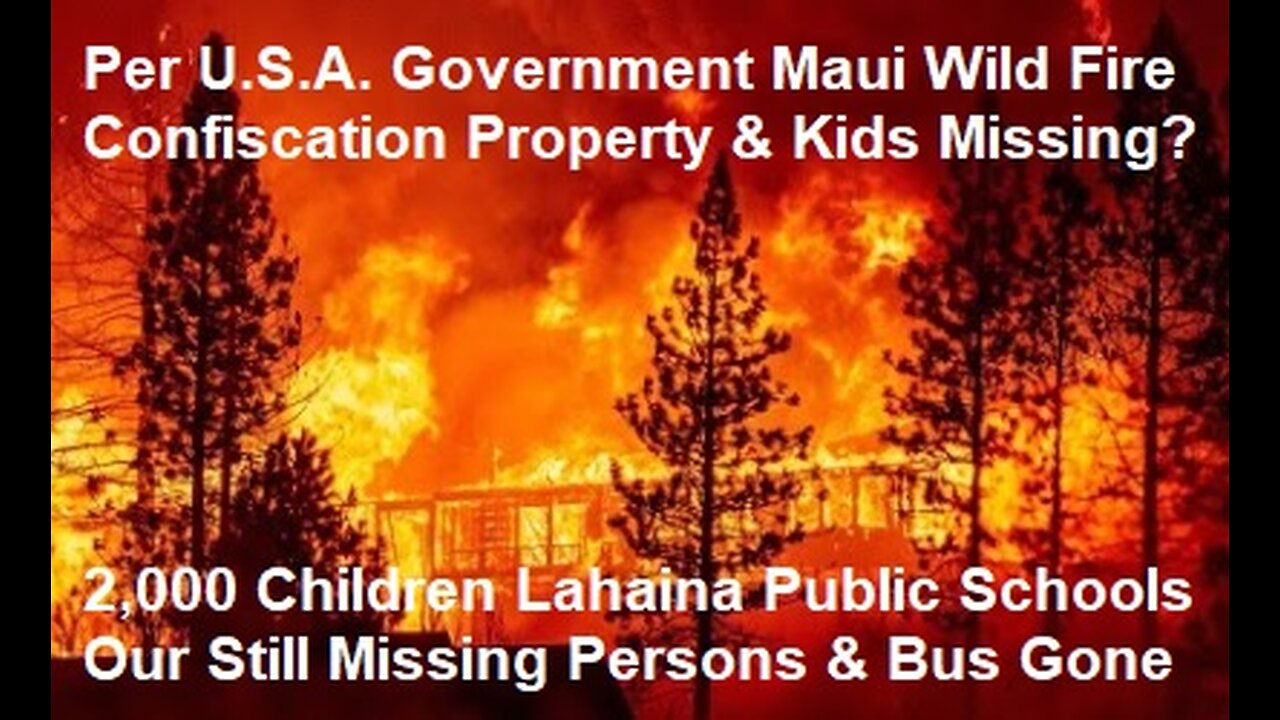Premium Only Content

Per U.S.A. Government Maui Wild Fire Confiscation Hawaii's Property & Kids Missing
Maui Wildfires Consuming Hawaii Leaving Thousand's Kids And Teens (Maybe Sold Sex Slave?) And Other People Missing Fleeing For Their Lives. How tragic that on Aug. 8 2023 the Maui town of Lahaina suffered America’s most deadly wildfire in a century costing hundreds of lives. Around here we can’t even guess at the suffering and these folks deserve our greatest support.
The entire story of the fire and situation sounds fishy, and people are upset at the fact that it seems as though content about the fires is being suppressed online. Maui officials are covering up the death toll. Still claiming people are “missing” in order to hide the horrific truth. Children burned alive. Maybe 2,000 or more dead body's of teen's to be found still alive some ware ?.
For alarmists though, Maui was a crisis not to be wasted to advance their crippling global warming agenda. High-level Biden officials shrieked for more massive programs to “fight global warming”. Disgusting.
The disaster was in fact driven by human activities, but not fossil fuels ? When the fire started in contact with water, aluminum releases heat and hydrogen, so the slightest accumulation of aluminum dust can become a source of heat capable of causing an explosion.
According to multiple officials, directed energy weapons were not involved in the recent wildfires in Hawaii, which killed 100s at least 1000+ kids missing people and destroyed more than 2,700 structures in the historic town of Lahaina. The cause of the fires has not been announced, but factors like dry vegetation and gusting winds could start and spread fires. Claims that laser were used to intentionally start the fires are unfounded, and fires can spread quickly and overwhelm vegetation, structures, and cars. Social media users have circulated photos of light beams and lasers that they claim were taken from Hawaii before the fires, but there is no evidence (Exp. Anything made in blue colors did not burn like blue cars) no evidence to support these claims. How about un-burn blue cars only etc. ?
Abandoned Sugar plantations became overrun with invasive non-native grasses creating an explosive tinder box. Authorities were warned and failed to act.
Power distribution systems built long ago to standards unacceptable today needed upgrading. Authorities were warned and failed to act.
Instead of focusing on eliminating these hazards, authorities concentrated on pursuing the zero-carbon fantasy.
During the red flag high wind alert, authorities failed to de-energize vulnerable power lines. Wiring was blown to the ground igniting long stretches of the culprit grass.
U.S.A. Killed People's And Take Over Attempted Overthrow of the Hawaiian Kingdom,1893 - https://youtu.be/QmavRFmJG_U?si=oSUVpRgObyRYiH8s
Keanu Sai explains the event in five minutes.
How Did the US Annex Hawaii & Steal Its Land ?
https://youtu.be/dEbWjpfwLYk?si=BUMB_HKznZSGah8F
Here's How America Destroyed Hawaiian Culture.
https://youtu.be/rD4sUyWwqNU?si=NzInsQG__GKefr1S
How America Stole The Land Of Hawaii 1893
https://youtu.be/-tw4CyxBJEQ?si=hV_GuY3AWBbxz0tr
Hawaii was an independent nation until January 17, 1893. That day, the archipelago and its monarchical government were overthrown illegally by the United States. Since then, the USA has taken over Hawaii illegitimately, turning the island into a military base that threatens world peace, while sovereignty groups organize to rescue its legitimacy.
https://www.govinfo.gov/content/pkg/STATUTE-107/pdf/STATUTE-107-Pg1510.pdf
President William Jefferson Clinton signing Public Law 103-150 in the Oval Office at the White House in Washington, D.C. The resolution acknowledged the 100th anniversary of the January 17, 1893 overthrow of the Kingdom of Hawaii and offered an apology to Native Hawaiians on behalf of the United States for the overthrow of the Kingdom of Hawaii.
Today, we're taking a deep, and honest, dive into American history.
Firefighters begged for release of water supplies. Authorities failed a timely approval.
Maui has an extensive disaster warning system. Authorities failed to activate it.
Residents tried to flee down the only road out. Authorities denied them passage.
Hundreds died needlessly because authorities they depended upon for their safety were preoccupied wasting time and squandering economic and human resources in pursuit of the silly notion that they would create nicer weather by “fighting global warming”. America needs a bold course correction.
Why Maui Wild Fire In Hawaii's Have Very High Levels Aluminum dust after the fires and it is a very high combustible material that poses a high risk of explosions, especially when suspended in the air. It can have different particle sizes and shapes, and each class has specific particle size and shapes. Aluminum dust can also form flammable alloys with magnesium and other metals. Unlike aluminum in bulk or solid form, aluminum in dust form poses a high risk of explosions, especially when suspended in the air. During fabricating operations, aluminum fines may be generated by such activities as grinding, polishing, sawing, cutting, sanding, or scratch brushing, and at least some of them will be fine enough to be potentially explosive. Aluminum dust tends to heat up and therefore to burn very easily. It is important to grind aluminum in a well-ventilated area to keep the dust volumes to a very low minimum.
While aluminum massive blocks or bars have a thin oxide layer which hinders the diffusion of oxygen and thus prevents a chemical reaction that could cause damage, aluminum dust, having a lower surface, tends to heat up and therefore to burn very easily. The biggest mistake you can make, therefore, is considering aluminum as a harmless material without taking into account its characteristics as a dust.
Following are the 5 most important aspects that all workers, particularly those operating in the Engineering and Manufacturing Industry, Food Industry, Pharmaceutical Industry and Construction Industry have to take into account when using machines that operate with aluminum or produce aluminum waste.
The 5 most dangerous aspects about aluminum dusts aluminum dusts easily react with oxygen at room temperature, so virtually any workplace operating with aluminum or producing aluminum waste must adopt a security plan.
The smaller the particles of aluminum dusts are the greater the risk of explosion or fire there is in an establishment. Particles smaller than 100 microns are considered dangerous. Anyone working in a pharmaceutical laboratory where aluminum hydroxide is used, for example, has definitely to use industrial vacuums with a high efficiency filtration to avoid any accident.
Large particles are even more dangerous, because its combustion speed is higher. It’s uncommon that explosive dusts are uniform, so surely aluminum particles of bigger sizes that are considred "safe" are mixed with small 100 microns particles. The result is a high risk of explosion coupled with a high rate of burning.
When the percentage of oxygen in the atmosphere is between 10% and 15% fire tends to spread more rapidly; a higher concentration of oxygen promotes explosions considered as violent. It is much easier to avoid the accumulation of aluminum dusts with a proper maintenance than to modify the concentration of oxygen.
When in contact with water, aluminum releases heat and hydrogen, so the slightest accumulation of aluminum dust can become a source of heat capable of causing an explosion. If impossible not to mix water and aluminum, you shall adopt a system of ATEX certified industrial vacuums and / or a vacuum that allows you to effectively separate dry from liquid materials.
Hawaii Wildfires Spark Conspiracy Theory About 'Directed Energy Weapons'
The devastating wildfires in Hawaii have brought a new conspiracy theory from climate change deniers who suggest that the destruction was orchestrated by the federal government's directed energy weapons (DEW).
Social media users are circulating photos of light beams and lasers that they claim were taken from Hawaii before this week's deadly fires burned down historic landmarks and killed at least 55 on the island of Maui.
"If the fires in Hawaii were natural, what in the h is this?" one user captioned a photo on X, formerly Twitter. The platform flagged the post with a warning that read, "Image captures an event that occurred in Michigan in 2018, not a current event in Hawaii."
"The Directed Energy Weapons (DEWs) being used on Hawaii are powerful enough to set the Pacific Ocean on fire," far-right online personality Stew Peters said.
DEWs involve "high energy lasers and other high power electromagnetics" that "use concentrated electromagnetic energy to combat enemy forces and assets," according to the U.S. Government Accountability Office (GAO).
Although the Defense Department has spent $1 billion annually on developing these weapons to take down missile and drone threats, an April 2023 GAO report says the department has had trouble deploying these technologies outside of labs because of a lack of transition planning.
The new conspiracies seem to arise from the fact that the Air Force Research Laboratory had devoted a whole wing to developing DEWs "for all air traffic intersecting Hawaiian airspace and territorial waters" in 2007, according to a Wired story. The Directed Energy Directorate is located at the Kirtland Air Force Base in New Mexico.
Newsweek reached out to the Air Force Research Laboratory via the press inquiry form on its website for comment.
State officials have said that various forms of extreme weather, like dry conditions, low humidity and high winds, set Hawaii up for the extreme wildfires, but their exact cause remains to be determined.
"We don't know what actually ignited the fires, but we were made aware in advance by the National Weather Service that we were in a red flag situation. So that's dry conditions for a long time—so the fuel, the trees and everything was dry," Major General Kenneth Hara of Hawaii's Department of Defense said.
The blazes began as scattered brush fires at the beginning of this week, but a rapid spread fueled by the lack of humidity and strong winds from Hurricane Dora turned them into the most lethal wildfires seen in the U.S. since 2018.
Tens of thousands of people have been evacuated, and the death toll is expected to rise as rescuers continue their search and recovery efforts. With Dora, a Category 4 storm, moving farther away from Hawaii and 80 percent of the fires contained, people are expected to be allowed to return by the weekend.
"What we saw was likely the largest natural disaster in Hawaii state history," Governor Josh Green said Thursday in a social media post and it looks like a bombing site or a chemtrails gas bomb started the fires ?.
What Are Chemtrails Made Of?
Believers in chemtrails say those trails are actually clouds of chemicals used by the government for nefarious purposes. But as Carl Sagan says, “extraordinary claims require extraordinary proof”
If you’ve never heard of chemtrails, don't fret. Before spending time in Southern California I hadn’t heard of them either. But whether it’s being in the land of obsession-with-healthy-living, or perhaps just being near a few major airports, I now hear about chemtrails quite frequently in SoCal.
So what are chemtrails? Should we be worried about their effects on our health?
What Are Chemtrails Made?
Chemtrails, short for chemical trails, are what some call the white trails you see left behind as a plane passes overhead. Believers in the chemical aspect of chemtrails say those trails are actually clouds of chemicals used by the government or someother large scale entity for a variety of nefarious purposes from weather modification, to human population control via sterilization, to even mind control. The theories usually claim that normal jet plane output should dissipate quickly so any clouds that do not disappear immediately must be full of additional, undisclosed substances. Chemtrail theories are not only a U.S.-based phenomena—almost 17% of respondents in an international survey noted a belief in the existence of a "secret large scale atmospheric program" to be at least partly true.
To address this concern, a group of 77 scientists published a report in the journal of Environmental Research Letters after digging through the supposed evidence of the intent to poison us through chemtrails. These scientists are experts in atmospheric science, including the contributions of aircraft to the atmosphere as well as atmospheric processes like how quickly or uniformly chemicals fall through the air to the ground. Of those 77 scientists, 76 said they found no evidence of a "secret large-scale atmospheric program"—that’s 98.7%. Instead, they found that "the data cited as evidence [for such a program] could be explained through other factors, including well-understood physics and chemistry associated with aircraft." In other words, the evidence pointed to the trails being simply the normally expected result of planes flying through the air.
As for that one scientist? One scientist noted that in one remote location, the levels of barium in the atmosphere were unusually high relative to the levels of barium in the soil. No claims were made that the reason for those elevated levels had to be a large scale chemical operation, but since that scientist was not convinced of a clear reason for the barium to be higher in the atmosphere there, they left the possibility open.
If you’ve never heard of chemtrails, don’t fret. Before spending time in Southern California I hadn’t heard of them either. But whether it’s being in the land of obsession-with-healthy-living, or perhaps just being near a few major airports, I now hear about chemtrails quite frequently in SoCal.
Chemtrails, short for chemical trails, are what some call the white trails you see left behind as a plane passes overhead. Believers in the chemical aspect of chemtrails say those trails are actually clouds of chemicals used by the government or someother large scale entity for a variety of nefarious purposes from opens in a new windowweather modification, to human population control via sterilization, to even mind control. The theories usually claim that normal jet plane output should dissipate quickly so any clouds that do not disappear immediately must be full of additional, undisclosed substances. Chemtrail theories are not only a U.S.-based phenomena—almost opens in a new window17% of respondents in an international survey noted a belief in the existence of a “secret large scale atmospheric program” to be at least partly true.
To address this concern, a group of 77 scientists published a report in the journal of Environmental Research Letters after digging through the supposed evidence of the intent to poison us through chemtrails. These scientists are experts in atmospheric science, including the contributions of aircraft to the atmosphere as well as atmospheric processes like how quickly or uniformly chemicals fall through the air to the ground. Of those 77 scientists, 76 said they found opens in a new windowno evidence of a “secret large-scale atmospheric program” – that’s 98.7%. Instead, they found that “the data cited as evidence [for such a program] could be explained through other factors, including well-understood physics and chemistry associated with aircraft.” In other words, the evidence pointed to the trails being simply the normally expected result of planes flying through the air.
As for that one scientist? One scientist noted that in one remote location, the levels of barium in the atmosphere were unusually high relative to the levels of barium in the soil. No claims were made that the reason for those elevated levels had to be a large scale chemical operation, but since that scientist was not convinced of a clear reason for the barium to be higher in the atmosphere there, they left the possibility open.
What Are Contrails?
The real name for chemtrails is actually contrails, short for condensation trails, because those clouds are actually mostly the result of the condensation of water vapor when hot exhaust expelled by a jet engine hits the very cold ambient air.
Jet fuel is made of hydrocarbons: molecules made up of a mixture of hydrogen and carbon atoms. When that fuel is burned, the chemical bonds holding those hydrogen and carbon atoms together releases energy to propel the plane forward, and the leftover hydrocarbon pieces get expelled and left to trail behind the plane. Much of the hydrogen combines with available oxygen to form H2O or water which makes up most of contrails.
Contrails are not that different from the exhaust you see coming from a car’s tailpipe on a cold day or even seeing your own breath when temperatures are low. According to the American Chemical Society, contrails are further opens in a new window expected to look different as they pass through regions of the air with different temperatures or humidity. (Similarly, your breath of hot air dissipates more slowly when the air has more moisture in it, but disappear quickly on drier days.)
The United States Environmental Protection Agency notes that opens in a new window contrails are completely safe opens pdf file. However, you are not likely to believe a fact sheet from the EPA if you think the government is behind the attempt to release toxic substances over wide swaths of the population. However, some scientists argue that the number of people required to pull off such a scheme (somewhere in the tens of thousands) would make a large-scale chemtrail effort incredibly opens in a new window difficult to keep secret. What’s more, we all share the same atmosphere, so those implementing the plan would also be putting themselves at risk.
As often noted by astronomer Carl Sagan, “extraordinary claims require extraordinary proof.” So far, that proof just doesn’t exist for chemtrails.
Letter Be aware of chemtrails If residents in this area looked at the sky works display on Thursday it would be clear that weather modification is real.
Instead of the usual scattered trails that dissipate over a few hours, the entire sky was blanketed with chem trails. They were successful in blotting out the sun for a good part of the day.
HAARP (High Frequency Auroral Research Program) was begun some years back to study the particulate matter of the atmosphere leading to methods of climate control and alteration.
One of the substances now being used is aluminum, which is not “body friendly.”
Politicians say nothing when challenged and asked about use of our own Air Force to implement this activity. Chem trails are now all over the country but perhaps more prevalent in the Southwest.
Block the sun to fight “global warming” is the mantra used by the secret powers in control. Aluminum and whatever else drifts down over human population.
What else might be behind spraying? I challenge people to wake up, do some research, and explore other motivations in some of what is happening all over the world.
There are questionable vaccines, altered food crops, continued dangerous pesticide spraying. There is no D.C. activity against Monsanto and Big Pharma.
Chem trails are not con trails from ordinary jet traffic. Ordinary con trails are narrow and disappear very quickly.
Most of the chem trails tend to run east to west, and the planes are at such a high altitude that they would not be coming from any nearby airport in this area.
Aluminum Dust from Geoengineering Fueling Super Wildfires According to New World Order discovered that unprecedented levels of aluminum and barium nanodust, primary components in chemtrails, both of which are incendiary, are fueling the ferocity of the super wildfires.
A retired USAF brigadier general, Gen. Charles Jones, has been quoted from a public source as stating, "These white aircraft spray trails are the result of scientifically verifiable spraying of aluminum particles and other toxic heavy metals, polymers and chemicals."
"Millions of tons of aluminum and barium are being sprayed almost daily across the U.S., stated Mills, a former naval officer and UCLA graduate. "Just sprinkle aluminum or barium dust on a fire and see what happens. It's near explosive. When wildfires break out, the aluminum/barium dust results in levels of fire intensity so great as to cause firefighters to coin a new term ? 'firenados,' " he said. The entire U.S., in addition to various other NATO countries, are being sprayed."
The government again and again has for years denied the existence of chemtrail spraying. It now calls the program by various names, all under Geoengineering.
According to Cal Fire operation chief Steve Crawford, the fires are burning differently and more aggressively. It has been reported the fires move faster than anyone has ever seen and barriers that in years past contained them such as rivers, no longer do.
In California's Mt. Shasta region, Francis Mangel, a USDA biologist tested and found elevated levels of aluminum in water and soil samples of 4,610 parts per million which is 25,000 times the safe guidelines of the World Health Organization.
Some have claimed Mr. Mills is publicity-seeking for his teen and young adult fiction adventure series, Matt Legend, about four teens who encounter and battle the supernatural and all kinds of strange things, including the forces behind the chemtrails. The adventure thriller is being called the new Harry Potter. Mr. Mills states the research speaks for itself and the novel is only what led to the discovery. "Authors are known for researching things to death," he stated. No one can argue, however, the wildfires' newfound ferocity or the millions of tons of aluminum/barium nanodust which have appeared, which is killing vegetation and causing illness and death.
More Than 2,000 Children From Lahaina Public Schools Still Missing After Maui Wildfires
There are still 850+ people missing from the Maui wildfires, but a new report from the Hawaii State Department of Education shows that there are more than 2,000 children who are unaccounted for in the public school system and the school buses are also missing too.
n early August, a catastrophic wildfire engulfed Lāhainā, Maui, leaving over 100 confirmed dead and 850 missing. The tragedy has ignited a firestorm of criticism directed at Hawaii's state government, particularly Governor Josh Green, for perceived inadequacies in emergency response and preparedness. The absence of warning sirens and a perceived lack of an official response to the disaster have drawn widespread condemnation. The fire coincided with the first day back at school for many students; schools had been closed due to an outage, leaving many children home alone. Tragic stories have emerged, including that of a 14-year-old who perished along with the family dog as his parents were trapped behind a police barricade.
Green's recent "Anti-Housing" proclamation, aimed at speeding up the construction of 50,000 new homes on Oahu, has further fueled public skepticism. Residents are concerned that developers will exploit the tragedy to build expensive hotels and condominiums, particularly as many of the destroyed properties lie along the coastline. Despite reassurances from Green, the fears persist, fueled by Maui's existing housing crisis and an average home price of $1.2 million.
Adding to the controversy is the state police chief, John Pelletier, who has a history of service during the 2017 Las Vegas shooting. The federal disaster declaration has not alleviated concerns; locals report minimal assistance in the wake of the disaster. For instance, the Department of Health initially blocked insulin-carrying flights, although the issue has since been resolved.
Critics also accuse state authorities and the media of downplaying the likely high number of child victims to protect the Biden administration and Hawaii Democrats. Social media commentators, influencers, and prominent figures have criticized the lack of aggressive media coverage, suggesting a deliberate attempt to cover up governmental failures. They claim that once the true toll becomes apparent, a reckoning is imminent for local government and media alike.
More Than 2,000 Children from Lahaina Public Schools Still Missing after Maui Wildfires
In a deeply concerning development, the Hawaii State Department of Education has reported that 2,025 students remain unaccounted for in the Lahaina public school system following a devastating fire on August 8 in Lahaina, Maui. Of the 3,001 students initially enrolled across four schools in the district, 538 have re-enrolled in other public schools, and 438 have enrolled in the State Distance Learning Program. However, the fate of the remaining 2,025 is still uncertain. The schools, comprising two elementary, one intermediary, and one high school, are currently closed due to fire damage. One elementary school is severely damaged and unlikely to reopen soon, while the others have suffered damage from winds, debris, and soot.
Private schools in Maui are also impacted. Maui Preparatory Academy received about 1,000 new applications and reshuffled its campus to accommodate 110 new students, a 40% enrollment increase. Sacred Heart School, with about 200 students, was destroyed by the fire.
Parents and community members feel particularly tormented, knowing many of the children were home alone when the fire struck.
The situation has left many survivors furious, wondering if a few more minutes of warning could have saved numerous lives. Some survivors or friends and family of survivors say that Maui residents were not warned sufficiently (or even warned at all) before the wildfires devastated their neighborhood. Parents and community members feel particularly tormented, knowing many of the children were home alone when the fire struck. One father, who managed to save his own children but not his neighbors', stated that even a 10-15 minute warning could have made a significant difference in saving lives.
This disaster has had a monumental impact on the educational and social fabric of Lahaina, exposing gaps in emergency preparedness, and putting a spotlight on the vulnerability of communities during natural disasters. The tragedy also underscores the immediate need for coordinated efforts in search and rescue, led in part by Combined Joint Task Force 50, involving the Hawaii Army and Air National Guard, Army active duty, and Reserve. These groups are working with Maui County authorities to provide immediate support to the community and first responders.
The Hawaii State Department of Education's report lists out "immediate needs," which include "caring for our people/health and welfare of affected school communities," "communicating with stakeholders," "supporting affected students," and "assessing and repairing facilities." The document also expresses the need for counseling services, particularly for the youth, and alternate locations for facilities while environmental testing still goes on to determine which areas are safe enough for residents. "Working on internet connectivity" has been an issue as well.
There are many people online who express disgust at the way this disaster has been handled, calling out the local Hawaii officials for not doing enough to protect the island's most vulnerable residents. Just a few days ago, the mayor of Maui appeared to be irritated at the question of how many children were missing.
"Maui officials are covering up the death toll. Still claiming people are 'missing' in order to hide the horrific truth," lawyer and filmmaker Mike Cernovich wrote on X, formerly known as Twitter, as he shared the video. "Children burned alive. Maybe 1,000 or more."
Many people suspect there is some kind of foul play, whether it's that the officials know exactly how many children are actually missing and they're not being forthright or that the officials did nothing at all to protect the children from being burned alive in the fires. Meanwhile, President Biden visited Maui and compared the tragedy to losing his 1967 Corvette in a fire once.
The entire situation sounds fishy, and people are upset at the fact that it seems as though content about the fires is being suppressed online. Even worse, it seems as though the mainstream media is not giving this the kind of front-page news it deserves. Outlets are reporting on it, but this should be the primary story that is plastered across every single newspaper and magazine. It should be all they talk about, but somehow, it keeps getting buried under other news that the journalists deem is more important.
The disaster has exposed systemic weaknesses in local governance, preparedness, and media accountability, revealing a collective failure to protect the most vulnerable. As the community mourns and waits for hundreds, maybe thousands, of missing people to be accounted for, the public debate is gradually shifting from mere recovery to a larger dialogue about governance, accountability, and the socio-economic future of Hawaii. Critics are calling for sustained scrutiny, warning against letting the authorities "move on from Maui" without facing the consequences of what they term a preventable tragedy.
LAHAINA, Hawaii - Many people with loved ones in Maui are desperately trying to locate them, with most of the island's communication systems still down.
As of Friday morning, about 1,000 people are still reported missing, following the disastrous wildfires that broke out on the island earlier this week.
But response teams say it's nearly impossible to determine how many people are still missing in Maui, due to the widespread communication problems.
Nikki White of Ohio is searching for her dad, T.K., a 65-year-old Air Force military police veteran, who was living in Lahaina.
On Wednesday, her father had told her by phone that he was in his car, seeking shelter.
"He was saying he couldn't get through to the places we were telling him to go because of the fire and structures were down," she said. "And then, just communication stopped. No one in our family has heard from him."
She said she reached out to the Red Cross, shelters and someone on Instagram, who was trying to help locate people – all to no avail. By Friday, at least 55 people were reported dead, and Lahaina was wiped out, officials said.
Fueled by a dry summer and strong winds from Hurricane Dora, the fire started Tuesday and took Maui by surprise, racing through parched brush covering the island and then flattening homes and anything else that lay in its path.
The fire is also the deadliest U.S. wildfire since the 2018 Camp Fire in California, which killed at least 85 people and laid waste to the town of Paradise.
Mandatory evacuation orders were in place for Lahaina residents, while tourists in hotels were told to shelter in place so that emergency vehicles could get into the area.
LAHAINA, Hawaii (AP) — A new fire burning on the Hawaii island of Maui on Friday night triggered the evacuation of a community to the northeast of the area that burned earlier this week, police said.
The fire prompted the evacuation of people in Kaanapali in West Maui, the Maui Police Department announced on social media. No details of the evacuation were immediately provided.
Traffic was halted earlier after some people went over barricaded, closed-off areas of the disaster zone and “entered restricted, dangerous, active investigation scenes,” police said.
The number of confirmed deaths from the Maui wildfires this week has increased to 67.
Maui residents had already started returning to their neighborhoods to find blackened hulks of burned-out cars, the pavement streaked with melted and then rehardened chrome. Block after block of flattened homes and businesses. Incinerated telephone poles, and elevator shafts rising from ashy lots where apartment buildings once stood. A truck bed full of glass bottles, warped into surreal shapes by the furious heat.
Anthony Garcia assessed the devastation as he stood under historic Lahaina’s iconic banyan tree, now charred, and swept twisted branches into neat piles next to another heap filled with dead animals — cats, roosters and other birds killed by the smoke and flames. Somehow it made sense in a world turned upside-down.
“If I don’t do something, I’ll go nuts,” said Garcia, who lost everything he owned. “I’m losing my faith in God.”
That was the scene residents found when they were allowed back home to take stock of their shattered homes and lives. The fire tore through parts of Maui and were still short of full containment and being battled by firefighters.
Attorney General Anne Lopez’s office announced it will conduct a comprehensive review of decision-making and standing policies leading up to, during and after the wildfires.
“My Department is committed to understanding the decisions that were made before and during the wildfires and to sharing with the public the results of this review,” Lopez said in a statement. “As we continue to support all aspects of the ongoing relief effort, now is the time to begin this process of understanding.”
Associated Press journalists also witnessed the devastation, with nearly every building destroyed on Front Street, the heart of Lahaina and the economic hub of the island. Surviving roosters, which are known to roam Hawaii streets, meandered through the ashes, and there was an eerie traffic jam of charred cars that didn’t escape the inferno.
“It hit so quick, it was incredible,” resident Kyle Scharnhorst said as he surveyed his apartment complex’s damage in the morning. “It was like a war zone.”
The wildfires are the state’s deadliest natural disaster in decades, surpassing a 1960 tsunami that killed 61 people. An even deadlier tsunami in 1946, which killed more than 150 on the Big Island, prompted the development of the territory-wide emergency system that includes sirens, which are sounded monthly to test their readiness.
But many fire survivors said in interviews that they didn’t hear any sirens or receive a warning that gave them enough time to prepare, realizing they were in danger only when they saw flames or heard explosions nearby.
“There was no warning. There was absolutely none. Nobody came around. We didn’t see a fire truck or anybody,” said Lynn Robinson, who lost her home.
Hawaii emergency management records show no indication that warning sirens sounded before people had to run for their lives. Instead, officials sent alerts to mobile phones, televisions and radio stations — but widespread power and cellular outages may have limited their reach.
Gov. Josh Green warned that the death toll would likely rise as search and rescue operations continue. Authorities set a curfew from 10 p.m. until 6 a.m. Saturday.
“The recovery’s going to be extraordinarily complicated, but we do want people to get back to their homes and just do what they can to assess safely, because it’s pretty dangerous,” Green told Hawaii News Now.
Fueled by a dry summer and strong winds from a passing hurricane, at least three wildfires erupted on Maui this week, racing through parched brush covering the island.
The most serious one swept into Lahaina on Tuesday and left it a grid of gray rubble wedged between the blue ocean and lush green slopes. Skeletal remains of buildings bowed under roofs that pancaked in the blaze. Palm trees were torched, boats in the harbor were scorched and the stench of burning lingered.
The wildfire is already projected to be the second-costliest disaster in Hawaii history, behind only Hurricane Iniki in 1992, according to calculations by Karen Clark & Company, a prominent disaster and risk modeling company.
Summer and Gilles Gerling sought to salvage keepsakes from the ashes of their home. But all they could find was the piggy bank Summer Gerling’s father gave her as a child, their daughter’s jade bracelet and the watches they gifted each other for their wedding.
Their wedding rings were gone.
They described their fear as the strong wind whipped the smoke and flames closer. But they said they were just happy that they and their two children made it out alive.
“It is what it is,” Gilles Gerling said. “Safety was the main concern. These are all material things.”
Cadaver-sniffing dogs were brought in to assist the search for the dead, Maui County Mayor Richard Bissen Jr. said.
The wildfire is the deadliest in the U.S. since the 2018 Camp Fire in California, which killed at least 85 people and laid waste to the town of Paradise.
Lahaina’s wildfire risk is well known. Maui County’s hazard mitigation plan, last updated in 2020, identified Lahaina and other West Maui communities as having frequent wildfires and a large number of buildings at risk of wildfire damage.
The report also noted that West Maui had the island’s second-highest rate of households without a vehicle and the highest rate of non-English speakers.
“This may limit the population’s ability to receive, understand and take expedient action during hazard events,” the plan noted.
Maui’s firefighting efforts may also have been hampered by a small staff, said Bobby Lee, president of the Hawaii Firefighters Association. There are a maximum of 65 firefighters working at any given time in the county, and they are responsible for three islands — Maui, Molokai and Lanai — he said.
Those crews have about 13 fire engines and two ladder trucks, but the department does not have any off-road vehicles, he said. That means crews can’t attack brush fires thoroughly before they reach roads or populated areas.
Maui water officials warned residents in Kula and Lahaina who have running water that it may be contaminated and they should not drink it — even after boiling — and should take only short, lukewarm showers “in a well-ventilated room” to avoid exposure to possible chemical vapors.
But Andrew Whelton, an engineering professor at Purdue University whose team was called in after the Camp Fire and the 2021 Marshall Fire in Colorado, said “showering in water that potentially contains hazardous waste levels of benzene is not advisable” and a do-not-use order would be appropriate until sampling and analysis have been done.
When she fled Tuesday, Lahaina resident Lana Vierra thought it would be temporary. She spent Friday morning filling out FEMA assistance forms at a relative’s house in Haiku.
Though she knew the home where she raised five children was gone, along with treasured items like baby pictures and yearbooks, she was eager to return.
“To actually stand there on your burnt grounds and get your wheels turning on how to move forward — I think it will give families that peace,” she said.
Riley Curran said he fled his home on Front Street after climbing up a neighboring apartment building to get a better look at the onrushing fire. He doubts county officials could have done more to stave off disaster, because it happened so fast.
“It’s not that people didn’t try to do anything. … The fire went from 0 to 100,” Curran said. and added that he grew up in California and has seen horrendous wildfires, but “I’ve never seen one eat an entire town in four hours.”
Maui crews installing dust screen around Lahaina to keep everyone out to hide the truth from all property owner's too. The state Department of Transportation is installing nearly 30,000 linear feet of dust screen for the protection of highway users on Honoapiʻilani Highway (Route 30) and the Lahaina Bypass (Route 3000).
The work started on Aug. 16 with Maui-based contractors teaming up for the project that should take about a month to complete. The teams are constructing a fence that will stretch more than 5 miles.
On Monday Aug. 21, HDOT was informed of $3 million dollars in quick-release Emergency Relief funding from the Federal Highway Administration for necessary work like this to maintain safe access to West Maui. Building the screen is estimated to cost $2.4 million dollars.
Federal, state, Maui County, and volunteer agencies continue recovery actions in Lahaina. Transportation department officials say the dust screens will not interfere with those efforts.
The dust screens will be maintained by HDOT crews and will remain up until further notice.
As a reminder, the County of Maui has limited access to Honoapiʻilani Highway between 10 p.m. and 6 a.m. to West Maui residents, first responders, and those working in West Maui. All motorists may enter from 6 a.m. to 10 p.m. daily.
Tourists snorkeling, taking photos in Lahaina a 'slap in the face,' Maui resident says The wildfires are also fanning the flames of resentment that have existed for decades.
In the wake of the wildfires that decimated Lahaina, Maui police set up a road block on Highway 30 that barred everyone but first responders to the historic beachside town. Then, about five days later, officials opened up the road to everyone each day from 6 a.m. to 10 p.m.
In recent days, visitors to the area have also included tourists, who have turned Maui's pain into a spectacle, some locals say.
"Our people haven't even had a time to grieve on our own," Courtney Lazo, whose family has lived on the island for about 10 generations, told ABC News.
The search for loved ones on Maui following the devastating wildfires has grown increasingly dire as the community grieves those lost in the blazes. So far, more than 110 people have been declared dead, with roughly 44 of the deceased identified. Between 1,000 and 1,100 individuals remain unaccounted for following the disaster, as of Aug. 22 2023.
The wildfires are also fanning the flames of resentment that have existed for decades, making some feel like tourists matter more than the islanders themselves.
"You have tourists taking pictures of the destruction in Lahaina while there's still bodies there. They're snorkeling off the waters while they're pulling people out of the water. It's just extremely frustrating, and it feels like a slap in the face," Lazo said.
On the road to Lahaina, Lazo's family created a sign that reads "Tourist Keep Out." Her uncle, Vance Dizon, survived the fires and then passionately helped his family make the sign, setting up a chair on the edge of their neighborhood fence and forming what they consider an unofficial checkpoint.
"In this time, it's kind of hard to accept people where, you know, our resources is short," Dizon said.
At the same time, the issue is complex. Despite the frustration, residents are also aware of the economic pressure to rely on tourism dollars, including Tapani Vuori, general manager of Maui Ocean Center at the Hawaii Aquarium.
"We hear that some of the boats are stopping their operations. They are laying people off. Oh, excuse me, I'm sorry. It's a little bit emotional. We will keep our operations open as long as we can, even if it means we don't have income coming in," Vuori told ABC News.
He also worries about how decreased tourism may affect recovery efforts.
"If it takes longer, it's going to be more painful for more people. So, let's keep it short," Vuori said.
Still, Lazo says her family made the sign because they want tourists to stay away from their pain, and at the same time acknowledging the systemic cycle they are in. "We definitely understand the value of tourism. Maui is open. Lahaina is closed, respectfully," she said.
Hawaii Wildfire Management Organization
Working with communities across Hawaii on wildfire prevention, mitigation, and planning activities in the Hawaii-Pacific region through proactive, collaborative, and forward-thinking projects.
2018-19 Rapid Assessment of Vegetation Management Results
For Citizens, For Decision Makers, For Educators, For Fire Scientists, For Firefighters, For Resource Managers, HWMO Products
In Hawaii, wildfire has devastating impacts on our communities and native ecosystems. With land use and climate changes, wildfire is a significant and growing hazard in many places across Hawaii.
Research in wildfire science shows that vegetation is a key ingredient in the recipe for recurring wildfire. Vegetation management is essential for wildfire hazard mitigation strategies that:
reduce wildfire hazard;
create safer conditions for firefighters; and
serve as key climate adaptation strategies for our communities, economies and environment.
Fire follows fuel and the impacts do not abide by property boundaries. Therefore, reducing wildfire hazard is a landscape-level issue that we need to collaboratively tackle together to create safer and more wildfire resilient communities.
In 2015, HWMO’s Technical Advisory Committee, comprised of more than 35 fire and natural resource experts from across the state, discussed Hawaii’s lack of consolidated landscape-level information on vegetative fire fuels treatments.
To start to fill the gap, HWMO conducted a Rapid Mapping Assessment and facilitated Collaborative Action Planning on Vegetation Management in 2018-19 to:
Better understand all of the important hazard reduction already happening by diverse land managers;
Identify and prioritize actions that address the island-wide fire issue to optimize expenditures and efforts and maximize protection at the landscape-scale;
To kick-start collaboration, information sharing, and integrate fire-thinking into current activities to address the cross-boundary fire risk.
We thank State Division of Forestry and Wildlife, University of Hawaiʻi CTAHR Cooperative Extension, and Pacific Fire Exchange for their collaborative support on this project. Funding was provided by Hawaiʻi State Grant-in-Aid Program, 2016, and the U.S. Forest Service, Pacific Southwest Region, under the terms of Grant No. 16-11052012-146 and No. 17-DG-11052012-143. USDA is an equal opportunity provider and employer.
We also thank the many mapping participants, workshop attendees, and survey respondents who made this all possible!
The summary results of the Rapid Mapping Assessment and Collaborative Action Planning can be found below.
The Hawaii Wildfires: The Role of Proper Vegetation Management around Power Lines in Wildfire Prevention If you’ve seen the news lately, you may have watched in horror as wildfires ravaged the beautiful island of Maui. There has been speculation that these wildfires may have been preventable (or at least more manageable) if vegetation around power lines had been properly cut back. Poor vegetation management around power lines is known to spark fires, and recent lawsuits have presented evidence that utility owners may be at least partially responsible for starting or exacerbating the wildfires in Hawaii. As experts in vegetation management, we wanted to weigh in and offer utility owners, property owners, and other concerned citizens with strategies to prevent these issues from happening near your home.
Before we begin, we want to acknowledge the devastation and the loss of life caused by these wildfires. Our hearts go out to all of the people who were impacted by this event. Please consider donating to the following organizations to help the communities and families affected by these fires:
What is Vegetation Management?
Vegetation management is a process by which agencies, companies, and individuals ensure that plant material is appropriate for its setting. This process sometimes involves removing plants that have gotten too large for their site, eliminating invasive or nonnative species from an area, or cutting back plants that interfere with an essential service like power lines. The main objectives of vegetation management are to avoid the disruption of essential services, to protect workers, and to limit environmental risks.
How does Vegetation Management Prevent Wildfires?
Plants nearby power lines can pose a danger if not properly maintained. Overgrown vegetation can interfere with power lines and create a fire hazard. When vegetation extends into the power line corridor, it can lead to an increased likelihood of sparking or a transformer explosion, and result in fire. This is exactly what many are speculating happened during the recent wildfires in Hawaii. A combination of dry conditions, winds, and an overgrowth of vegetation near power lines can lead to severe fire outbreaks anywhere. Addressing this issue is vital in ensuring that similar incidents do not happen again in the future.
Power lines are not the only issue, though. Forest management is another way in which landowners and government agencies can prevent wildfires. Careful management of forests through prescribed burns and hazardous fuels reduction can ensure that if a wildfire breaks out, it can be effectively extinguished. Some wildfires are completely natural phenomena and are nature’s way of taking care of itself. There are certain tree species that need fire in order to reproduce, and fire is essential to the health of many ecosystems. Proper forest management is essential to ensure that fires are kept under control and away from communities.
Who is Responsible for Vegetation Management?
Utility companies hold the primary responsibility for monitoring and managing the vegetation near their power lines. The Federal Energy Regulatory Commission (FERC) rules require power line owners to keep vegetation cleared at a minimum distance from power lines. Any homeowner who notices untrimmed vegetation near power lines on their property are asked to notify their local power company. Homeowners can also take steps on their own to manage vegetation near power lines. These steps can include having trees pruned that could interfere with power lines and managing any vegetation on their property. Professional tree services can often provide pruning for trees near power lines safely without causing damage to the trees. Power companies often cut trees back severely from power lines, leading to health issues and even the death of these trees. It is extremely important for homeowners NOT to try to prune trees or shrubs nearby energized power lines on their own. This is an extremely dangerous job that requires special expertise, tools, and often, coordination with the power company.
It is essential that we all become proactive in addressing the problem of overgrown vegetation near power lines. Just like homeowners can make requests to local power companies to cut back untamed vegetation near their properties, we can do the same for overgrown vegetation in public areas. If you notice vegetation that is growing too close to power lines, be sure to notify your local power company as soon as possible. Failure to act can lead to devastating results.
In conclusion, the recent wildfires in Hawaii highlight the urgency of proper vegetation management near power lines. Many times, disasters like these are preventable through proactive action. Utility owners and homeowners can work together to prevent devastating fires by ensuring that vegetation management standards are met. Our goal in writing this article is to raise awareness for the importance of vegetation management in preventing tragedies like the one recently experienced by the residents of Maui. We can all play a role in creating safer conditions for our communities by holding power companies accountable for proper vegetation management around their power lines.
Timeline: How the deadly wildfires took over Maui day by day
A perfect storm of strong winds and dry conditions left Maui vulnerable.
Dozens of people have been killed in the devastating Maui wildfires that also left thousands of structures -- including homes, businesses and cultural centers -- destroyed.
The fires crept up on residents and tourists of the Hawaii island of Maui on Aug. 8, as a perfect storm of strong winds and dry conditions left Maui vulnerable to what state officials say has become the deadliest natural disaster in the state's history.
Here is how the disaster turned deadly, slowly blazing through several separate parts of the island.
Monday, Aug. 7: Maui faces high winds
The National Weather Service recorded incredibly high wind gusts across Hawaii, with a high-wind warning issued by the organization for portions of Maui County through 6 a.m. Wednesday.
Some regions would go on to face wind gusts up to 67 miles per hour throughout the week, which officials say fueled the strength of the wildfires across the island.
Maui has been in a drought, according to the National Integrated Drought Information System, which also created the perfect storm for the incoming blazes.
Before 11 p.m. A security camera at the Maui Bird Conservation Center, located in the east Maui region of Upcountry, captures a bright flash in the woods just before 11 p.m.
"It's windy, and then there's a flash, and I think that's when a tree is falling on a powerline," says Jennifer Pribble, a senior research coordinator at the Conservation Center, who is narrating the footage. "The power goes out, our generator kicks on, the camera comes back online, and then the forest is on fire."
Tuesday, Aug. 8: The blazes are reported
12:20 a.m. Just after midnight, a brush fire was reported in the Kula area in the central part of Maui, according to officials. This would become the Upcountry Maui wildfire.
6 a.m. In the early morning hours, around 6:30 a.m., a brush fire of about three acres was reported around Lahainaluna Road, which passed through this historic town of Lahaina in West Maui.
9 a.m. The fire in Lahaina was declared 100% contained just before 9 a.m., according to Maui County officials.
"Containment indicates what percentage of the fire perimeter has been enclosed by a control line," the Maui County website states.
3 p.m. Officials report the perimeter of the Upcountry fire has spread about 1,000 acres and reached as far as Kualono Place near the Kula Lodge.
An afternoon flareup of the Lahaina fire forces the closure of Lahaina Bypass. Throughout the town, residents are trying to make their escape.
Residents from both regions continue to evacuate, as both the mayor and local fire officials urge caution.
"The fire can be a mile or more from your house, but in a minute or two, it can be at your house," said Fire Assistant Chief Jeff Giesea. "Burning airborne materials can light fires a great distance away from the main body of fire."
Around 5 p.m. The situation in Lahaina grows increasingly dire. The next hour becomes a collection of life-or-death decisions for those who remained in Lahaina. Video footage captures people fleeing the blaze, in some cases abandoning their cars, jumping into the ocean or pools for safety.
One man, Denny Yuckert, records himself in the standstill traffic on the city's Front Street. He can be heard saying: "If I make it, that'll be a good thing."
At 5:15 p.m., a woman named Kristina Lee-Garrido and her friend decide they don't have time to flee lower Lahaina. They recorded the blaze around them from the Aina Nalu hotel pool as fire pressed in on all sides.
Around 5:30, another family abandons their car and jump into the ocean.
By 6 p.m, Yuckert has left behind his car and is on the rocks of the harbor with dozens of others who watch as the cars and buildings they abandoned burn.
9:45 p.m. Mayor Richard Bissen issued an emergency proclamation in response to the fires.
The Pulehu/Kihei fire in the southern part of Maui also begins Tuesday.
Aug. 9
West Maui is without power and has no landline or cellphone service.
3:00 p.m. Firefighting crews are continuing to battle the Lahaina, as well as fires in the Pulehu/Kīhei and Upcountry areas.
3:30 p.m. A federal team arrived in Maui and is on the ground in Lahaina to assist with search and rescue efforts amid the active Lahaina fire. Early reports show six lives lost, but the toll was expected to climb.
"This is a deeply somber day," said Mayor Bissen. "The gravity of losing any life is tragic. As we grieve with their families, we offer prayers for comfort in this inconsolable time."
Aug. 10
10:30 a.m. The Lahaina fire was reported to be 80% contained, after the Fire Department reported progress in fighting all three fires across Maui.
The Pulehu fire was reported to be 70% contained, "after heavy equipment was used to create firebreaks through the night," according to Maui officials.
A containment percentage for the Upcountry fire remained pending.
Officials announced the death toll had risen to 55 people.
Aug. 11
3:00 p.m. Officials announced the Lahaina fire is 85% contained, the Pulehu/Kihei fire is 80% contained and the Upcountry Maui fire is 50% contained.
6:10 p.m. A Kaʻanapali fire reported above Puʻukoliʻi at 6:10 p.m. was reported to be 100% contained before 8:30 p.m.
The death toll rose to roughly 80 deceased.
Aug. 12
The fire in the Puʻukoliʻi and Kaanapali region was extinguished, impacting one acre.
Meanwhile, firefighting crews fought to extinguish flare-ups in the Lahaina and Upcountry fires, both of which had destroyed dozens of structures combined.
The Pulehu/Kīhei fire was declared 100% contained Saturday.
The death toll rose to 93.
Aug. 13
The Upcountry fire is deemed 60% contained, impacting an estimated 678 acres.
The Lahaina fire was deemed 85% contained, impacting an estimated 2,170 acres.
The Pulehu/Kihei fire was 100% contained.
By this time, the Pacific Disaster Center states that an estimated total of 2,719 structures were exposed to the Lahaina fire -- 2,207 structures were damaged or destroyed, and 2,170 acres burned. Of the buildings exposed to the fire, 86% were classified as residential, according to the center.
In Kula, the center reports at least 544 structures have been exposed, with 96% of them being residential.
The fires have cost billions of dollars in damage, state Gov. Josh Green said in a press conference Sunday.
Hawaii Gov. Josh Green (D) said that children are among the 850 residents who are still reported missing as authorities continue to search for causalities in the aftermath of the Maui wildfires.
In an appearance on CBS’s “Face The Nation,” Green told moderator Margaret Brennan that more than 100 residents were killed in the Lahaina wildfire. Green noted that there is a possibility that many of the children who are missing were at home due to school closures when the fires happened.
Maui Mayor Richard Bissen said Monday that 850 individuals are still missing, noting that this is a decrease from the 2,000 missing individuals who were initially reported. Bissen also said 27 of the 114 confirmed deceased victims have been identified.
The Maui Police Commission unanimously decided against disciplining Maui Police Chief John Pelletier after reviewing complaints from MPD employees. Pelletier, a former police captain in Las Vegas, took the helm of the department in December 2021 and has been welcomed by some officers and community members as someone who might shake up a department that had been plagued by controversy and allegations of corruption. The commission expressed its strong intention to foster the healing and growth of the department and its leadership. Pelletier hired a coach to address management style, which the commission will examine further during his next annual review.
“That is possible. And that’s — that’s what we’re sharing here internally, that it’s possible that there will be many children,” Green told Brennan. “This is the largest catastrophe and disaster that’s ever hit Maui, probably that’s ever hit Hawaii outside of wartime events.”
Green also said that children who survived the wildfires will be returning to school later in the week, noting there’s already necessities and resources in place to help families get back on their feet.
“You have to remember this is a very rural part of Hawaii. And that’s one of the challenges. So schools are far apart,” Green added. “We’ve authorized other means of transportation, you know, vans and things to help families get farther distances to school.”
This comes as Maui County officials said a day before that an estimated 2,170 acres of land in Lahaina was burnt, with thousands of structures being damaged or destroyed.
-
 32:15
32:15
What If Everything You Were Taught Was A Lie?
10 days agoThe Sacred Secrets Of Sound Arts Of Instruct Healing & Enlighten A Divine Source Secrets Universe
1.67K1 -
 28:36
28:36
Afshin Rattansi's Going Underground
1 day agoDoug Bandow: ENORMOUS DAMAGE Done to US’ Reputation Over Gaza, Trump ‘Easily Manipulated’ by Israel
19.7K29 -
 2:45:13
2:45:13
Barry Cunningham
13 hours agoCBS CAUGHT AGAIN! CHICAGO A MESS! LISA COOK IS COOKED AND MORE LABOR DAY NEWS!
96.7K47 -

StevieTLIVE
7 hours agoMASSIVE Warzone Wins on Labor Day w/ Spartakus
23.6K1 -
 10:46:42
10:46:42
Rallied
13 hours ago $13.15 earnedWarzone Challenges w/ Doc & Bob
193K4 -
 3:26:25
3:26:25
Joe Donuts Live
6 hours ago🟢 Lost in Space with My Clones: The Alters Adventure Begins
32K4 -
 7:20:22
7:20:22
Dr Disrespect
15 hours ago🔴LIVE - DR DISRESPECT - TRIPLE THREAT CHALLENGE - WINNING AT EVERYTHING
217K12 -
 2:35:33
2:35:33
Chrono
7 hours agoBirthday-eve Stream | Helldivers II
27.7K1 -
 54:40
54:40
BonginoReport
1 day agoLABOR DAY SPECIAL! The Best of Nightly Scroll - Nightly Scroll w/ Hayley Caronia (Ep.124)
134K15 -
 2:39:21
2:39:21
Joker Effect
5 hours agoReviewing the downfall of Kick Streaming. Kick streamers welcome to Rumble! Stake bombshell found!
36.9K1